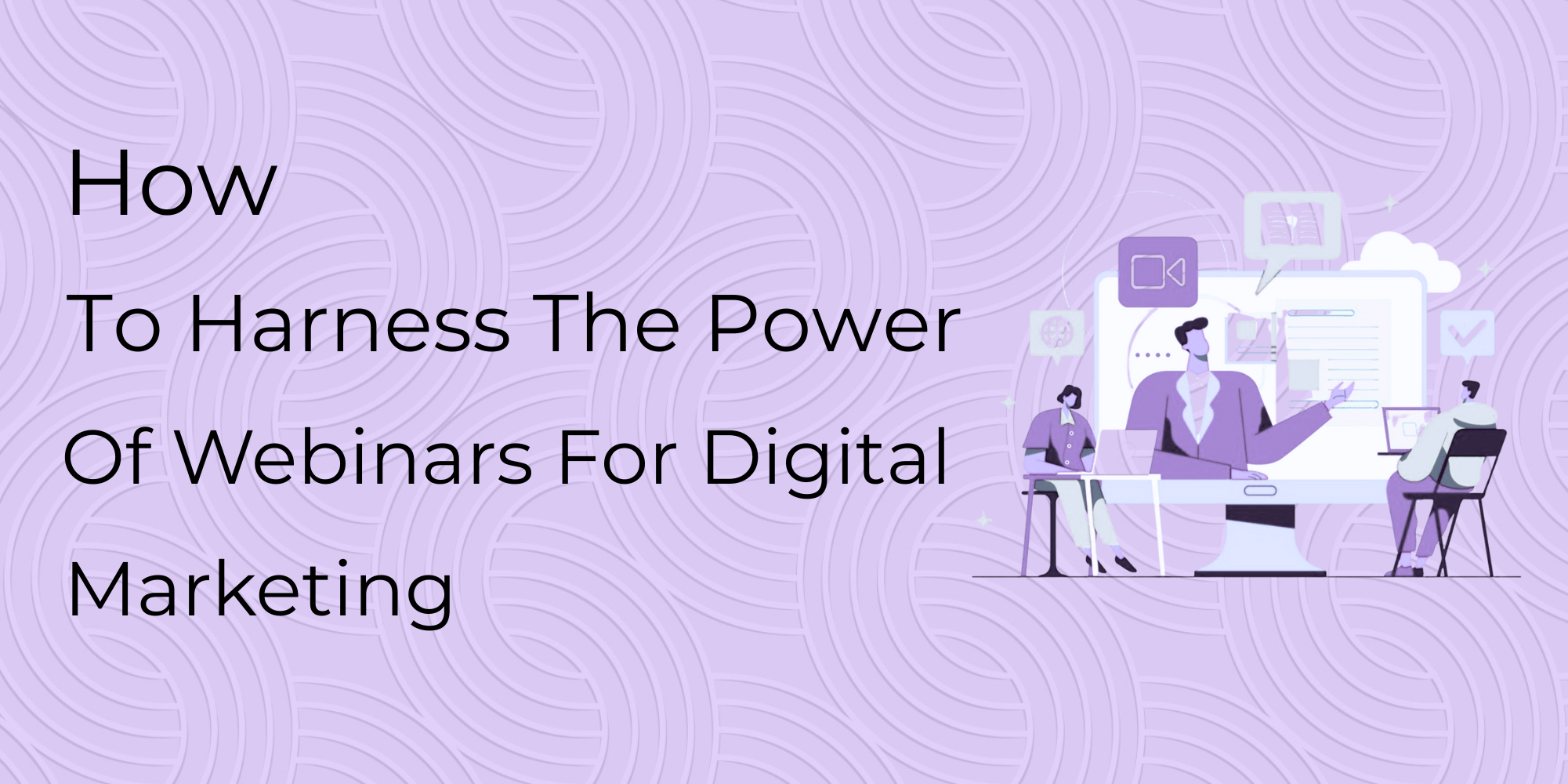In today’s fast-changing digital marketing landscape, it is crucial to stay ahead of the curve. One weapon that has become incredibly popular and effective is the webinar. Webinars, which are short for web-based seminars, provide businesses with a potent method of educating, engaging, and converting audiences in real time. From brand awareness to lead generation and selling, webinars can help drive a variety of digital marketing objectives.
● Table of Contents
- What is a webinar?
- Why Webinars Work for Digital Marketing
- Marketing Webinar Types
- Planning a Successful Webinar
- Marketing Your Webinar
- Keeping Your Audience Engaged
- Post-Webinar Strategy
- How to Measure Webinar Success
- Final Thoughts
● Why Webinars Work for Digital Marketing
Webinars possess several unique benefits that make them particularly well-suited for digital marketing campaigns:
- Lead Generation
Webinars draw in people who are really interested in the subject matter, so they are good leads. Participants typically register using their email, which gives them a direct connection. - Audience Engagement
Since webinars are live, you can engage your audience through chat, polls, and Q&A. This gets your audience active and more likely to convert. - Thought Leadership
Hosting a webinar makes your brand an authority. Sharing valuable knowledge builds credibility and trust, which are key drivers for driving buying decisions. - Budget-Friendly
Webinars eliminate travel, venue costs, and print materials, providing an inexpensive method to engage global audiences. - Repurposable Content
Webinar recordings can be repurposed into blog posts, podcasts, social media bites, and so on—getting the most out of your content ROI.
● Types of Webinars for Marketing
There are a few different formats you can employ based on what your marketing objective is:
- Teaching Webinars
These are intended to educate or teach something of value. They are not direct selling but giving actionable information that assists your audience. - Product Demonstrations
Perfect for highlighting features, benefits, and practical use scenarios of your product or service. - Panel Discussions or Interviews
Invite industry experts to discuss trends, challenges, or insights. These webinars attract large audiences and build credibility. - Case Study Webinars
Showcase how your product helped a client achieve specific results. These are powerful for convincing potential buyers. - Live Q&A Sessions
Answer questions from your audience in real-time. It shows transparency and builds a deeper connection.
● Planning a Successful Webinar
Effective webinars don’t happen by accident—they’re carefully planned. Here’s how to do it:
- Establish Clear Goals
What are you looking to accomplish? Lead generation, product sales, brand awareness, or something more? - Determine the Right Topic
Select a topic that resonates with your audience’s pain points, needs, or interests. Conduct surveys, social media, or keyword research to decide what your audience is interested in. - Pick Your Speakers Carefully
Your host or speakers need to be interesting, believable, and informative. Great presenters make the audience focus and motivated. - Select the Right Platform
Select a webinar platform that best suits your requirements. Mainstream options are Zoom, GoToWebinar, WebinarJam, and Demio. Ensure that they have features such as screen sharing, chat, polls, and analytics. - Design a Registration Page
Create a strong landing page with a grabbing headline, a straightforward value proposition, speaker profiles, and an easy registration form.
● Planning a Successful Webinar
Great webinars don’t occur randomly-they’re planned. Here’s how:
- Set Clear Goals
What are you going to do? Are you going to generate leads, sell products, build awareness for your brand, or something else? - Choose the Right Topic
Choose a topic that is relevant to your audience’s pain points, needs, or interests. Conduct surveys, use social media, or conduct keyword research to know what your audience is interested in. - Choose Your Speakers Carefully
Your speakers or host should be interesting, credible, and authoritative. Great presenters engage and keep the audience focused and motivated. - Choose the Right Platform
Select a webinar platform that works for you. Some of the most well-known tools are Zoom, GoToWebinar, WebinarJam, and Demio. Consider having screen sharing, chat, polls, and analytics. - Design a Registration Page
Develop a compelling landing page with a grabbing title, a good value proposition, speaker information, and a straightforward registration form.
● Marketing Your Webinar
You can’t expect people to magically show up. Promotion is the key to a successful webinar.
- Email Marketing
Send custom invitations to your email list. Send reminders 1 week, 1 day, and 1 hour before the event. - Social Media
Market on LinkedIn, Twitter, Instagram, and Facebook. Utilize countdowns, teaser videos, and hashtags. - Paid Ads
Utilize targeted Facebook, Instagram, or Google Ads to target new people based on interests and behavior. - Influencer Outreach
Encourage industry influencers or partners to post about the event to their audiences. - Website Banners and Popups
Put the webinar on your blog or home page with CTAs.
● Engaging Your Audience
Half the battle is getting people to attend—keeping them engaged is the other half.
- Start Strong
Start with a strong hook or statistic. Outline the agenda and tell participants what they will learn. - Use Visuals
Steer clear of text-dense slides. Incorporate images, infographics, and brief videos to keep the session interactive. - Encourage Interaction
Use polls, quizzes, and chat boxes to interact with your audience. Pose questions and respond to answers live. - Talk Directly to the Audience
Talk to the viewers, not at them. Use transitional phrases such as “you may be wondering…” or “what this has to do with you is…” - Provide Incentives
You can provide a downloadable free resource or special discount at the end of the offer to keep the attendees until the end.
● Post-Webinar Strategy
Don’t stop when the camera does.
Post-webinar strategy matters as much.
- Send a Thank You Email
Add a link to the replay, highlights of what was discussed, and a CTA (e.g., book a demo, download a guide). - Share the Replay
Make the recording available on your website, YouTube channel, or gated landing page to capture additional leads
. - Follow-Up with Attendees
Segment your list into:
- Attendees: Reward with more resources or one-on-one follow-up.
- No-shows: Invite them to the next one and send them the replay.
- Repurpose the Content
Transform the transcript into a blog post, social media bite-sized quotes, or podcast episode. Use highlights and quotes to make the webinar’s life longer.
● Measuring Webinar Success
Measure the following metrics to assess performance and improve future events:
- Registration rate (landing page visitors vs. signups)
- Signup vs. attendance rate
- Participation rate (polls, chat)
- Duration of stay (retention rate)
- Post-event desired actions (conversion rate) or sales
- Surveys and feedback (audience satisfaction)
Use Google Analytics, your email CRM, and your webinar platform’s native analytics to track these.
Final Thoughts
Webinars are not just a buzz term—they’re a tested and proven digital marketing tool that instills trust, informs your audience, and generates conversions. With an effective plan, you can convert one single live session into a successful multi-channel campaign that drives brand authority and develops leads for months.
Summing it up:
- Plan with purpose
- Promote effectively
- Deliver engaging content
- Follow up diligently
- Measure and optimize
The best part? As virtual events become more normalized, your audience is increasingly willing—and even eager—to attend.


